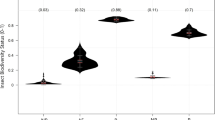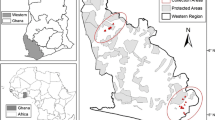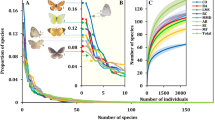Abstract
Predicted species lists are generated from regional species pools, coupled to codified habitat, microhabitat and biological trait data for the species. At site level, habitat association data are used to tailor the predicted list to site conditions and comparison between predicted and observed species lists is used to explore elements of site quality and site management options involving microhabitat and trait data for the species in the process. It is pointed out that this approach makes possible the interpretation of insect species lists by non-specialist site managers. At larger geographic scales, attributes of regional lists are identified. Throughout, the approach is considered in the context of its potential to contribute to resolution of issues relating to maintenance of biodiversity in Europe and the taxonomic group employed is the Syrphidae (Diptera).
Similar content being viewed by others
References
Caley, M.J. and Schluter, D. (1997) The relationship between local and regional diversity. Ecology 78, 70-80.
Castella, E. and Speight, M.C.D. (1996) Knowledge representation using fuzzy-coded variables: an example with Syrphidae (Diptera) and the assessment of riverine wetlands. Ecological Modelling 85, 13-25.
Devillers, P., Devillers-Terschuern, J. and Ledant, J.-P. (1991) Habitats of the European Community. CORINE Biotopes Manual, Data specifications, Part 2, 1-300. Office for Official publications of the European Communities, Luxembourg.
IUCN (1994) IUCN Red List Categories, prepared by the IUCN Species Survival Commission, as approved by the 40th. Meeting of the IUCN Council, Gland, Switzerland, 30 November, 1994. Gland, Switzerland.
Keddy, P.A. (1992) Assembly and response rules: two goals for predictive community ecology. J. Veg. Sci. 3, 157-65.
Pärtel, M., Zobel, M., Zobel, K. and van der Maarel, E. (1996) The species pool and its relation to species richness: evidence from Estonian plant communities. Oikos 75, 111-17.
Romau, C. (1996) Interpretation manual of European Union habitats, version EUR 15, 102 pp. European Commission, Brussels.
Speight, M.C.D. (1996) Syrphidae (Diptera) of Central France. Volucella 2, 20-34.
Speight, M.C.D. (1997) Invertebrate species lists as management tools: an example using databased information about Syrphidae (Diptera). Proc. Colloq. conservation, management and restoration of habitats for invertebrates: enhancing biological diversity. Environmental Encounters Series, No. 33: 74-83. Council of Europe, Strasbourg.
Speight, M.C.D. (1998) Species accounts of European Syrphidae (Diptera): the Atlantic zone species (revised). Syrph the Net publications 7, 1-190. Dublin.
Speight, M.C.D. (1999) Syrph the Net: A database of biological information about European Syrphidae (Diptera) and its use in relation to conservation of biodiversity. In Biodiversity: The Irish Dimension (B. Rushton, ed.), pp. 156-71. R. Ir. Acad., Dublin.
Speight, M.C.D., Castella, E. and Obrdlik, P. (1998) Use of the Syrph the Net database. Syrph the Net publications, 6: 1-104, Dublin.
Speight, M.C.D., Castella, E., Obrdlik, P. and Schneider, E. (1997) Are CORINE habitats invertebrate habitats? In The importance of chorology to invertebrates (H. Schreiber, ed.), pp. 193-200. Proc. 10th. Int. Colloq. EIS, Saarbrucken.
Zobel, M. (1997) The relative role of species pools in determining plant species richness: an alternative explanation of species coexistence? Tree 12, 266-9.
Zobel, M., van der Maarel and Dupré, C. (1998) Species pool: the concept, its determination and significance for community restoration. Appl. Veg. Sci. 1, 55-66.
Author information
Authors and Affiliations
Corresponding author
Rights and permissions
About this article
Cite this article
Speight, M.C., Castella, E. An Approach to Interpretation of Lists of Insects Using Digitised Biological Information about The Species. Journal of Insect Conservation 5, 131–139 (2001). https://doi.org/10.1023/A:1011399800825
Issue Date:
DOI: https://doi.org/10.1023/A:1011399800825




